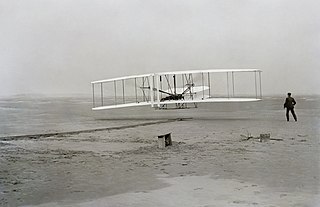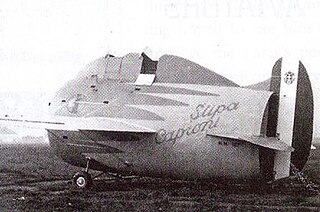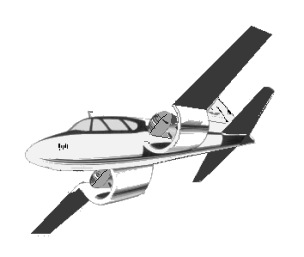
The Custer Channel Wing was a series of American-built experimental aircraft designs of the 1940s and 1950s incorporating a half-barrel shaped section to each wing.

The Custer Channel Wing was a series of American-built experimental aircraft designs of the 1940s and 1950s incorporating a half-barrel shaped section to each wing.
In 1925, Willard Custer noticed how very strong winds had managed to lift the roof of a barn. He realized that the high velocity of the wind created a lower pressure above the roof while the pressure remained high inside, literally lifting the roof off. This low pressure above/high pressure below is the same phenomenon that allows an airplane wing to provide lift.
Custer developed a wing design incorporating a semi-circular channel or "half barrel" shape in which an engine was to be fitted, in order to draw air over the wing and, in 1929, he received a United States patent. [1]
The arrangement is intended to draw enough air over the wing, even when moving slowly, to create sufficient lift to fly. Custer claimed that this layout, the channel wing, gave STOL operating capabilities and resulted in a design "which is an aircraft not an airplane. It does not plane the air to fly, rather it brings the air to the lift surfaces and reduces pressure to fly at 8 to 11 mph." [2]


The first aircraft to incorporate Custer's concept was the CCW-1 which was fitted with a single-seat and was powered by two 75 horsepower (56 kW) Lycoming O-145 pusher engines. Registered NX30090 in the FAAs experimental category, the sole example first flew on 12 November 1942 during a solo flight that was quite unintentional. Custer, who was a non-pilot, taxied the aircraft in a demonstration for financial backers and it suddenly became airborne. A hard landing followed, and one landing gear collapsed, but this did not dampen his backers' enthusiasm. [2]
The prototype was test flown by Frank D. Kelley, who would become a partner in the National Aircraft Corporation with Custer. The Channelwing concept was demonstrated with scale wind tunnel tests for the United States Army Air Forces in Dayton in June 1944, and again, in 1946, with 53 different configurations. [3]
NX30090 was donated to the National Air and Space Museum and displayed at Silver Hill, Maryland. [4] : 298
This was an evolution of the CCW-1 as a single-seat test bed and used an adapted uncovered fuselage of a Taylorcraft BC-12 light aircraft, replacing the single engine with two pusher engines fitted each side of the fuselage and placed within the wing channels. [5] The sole example N1375V first flew on July 3, 1948. It was flown for about 100 hours of testing with take-off and landing being made within 45–65 feet (14–20 m). Despite the claim of "flying better than a conventional aircraft," it was calculated that a stock Piper Cub was more efficient, lifting 18 lb/hp (11 kg/kW) versus the CCW-2's 11 lb/hp (6.7 kg/kW). [2] The CCW-3 and CCW-4 designations were not used.
In 1951, Custer formed the Custer Channel Wing Corporation with a registered address at 1905 West Washington Street, Hagerstown, Maryland.
Taylorcraft Inc of Conway, Pennsylvania were the first manufacturers to be licensed for the production of both military and private aircraft using the Channel Wing principles. [5] The first type intended to be produced was an experimental military aircraft to comply with United States Air Force specifications for a liaison aircraft. It was to carry a pilot and three fully equipped combat troops or 10 litter patients. Performance envisaged was a 1,000-pound (450 kg) load, cruising at 150 knots (280 km/h; 170 mph) or better over a five-hour cruise range. [5] Taylorcraft never put the plans into action. A design had been prepared by early 1952 for a single-engined channel wing aircraft with the engine fitted in a single channel immediately behind the crew cabin, [5] but this aircraft was not built. Design numbers CCW-3 and CCW-4 were not used.
In 1978, Custer filed an US$ 80 million (equivalent to US$ 359 million in 2022) suit [6] against the designers of the A-10 for using his idea of induced lift from the proximity of the engines to the wings. The suit was dismissed. [3]
Custer's Corporation went on to develop and build the five-seat CCW-5, intended for commercial sale. The first example N6257C was designed by Custer but built by the Baumann Corporation of Santa Barbara, California. It utilized an adapted fuselage and tail assembly of a Baumann Brigadier. Power was from two pusher 225 h.p. Continental O-470 engines. The first flight was made on July 13, 1953 . [2]

The second example N5855V was manufactured at the Custer factory. It again used a Baumann Brigadier fuselage and tail assembly. This aircraft first flew on June 19, 1964. Although several firms expressed interest in production of the design, all failed to provide the necessary downpayment. [2]
The CCW-5 accommodated five persons, and its power plants are suspended in the center of the 6-foot (1.8 m)-chord wing channels on tubular frameworks attached to the wing spars. The aircraft draws air through the channels at high velocity, decreasing pressure over the wings and increasing lift. The CCW-5 was claimed to be capable of flying at a sustained speed of 35 miles per hour (56 km/h). [7]
The CCW-5 continued to make developmental flights during the 1960s and 1970s, but no production orders were obtained.
N5855V was donated to the Mid-Atlantic Air Museum at Reading Airport, Pennsylvania and is on restricted display. [4] : 453

The ERCO Ercoupe is an American low-wing monoplane aircraft that was first flown in 1937. It was originally manufactured by the Engineering and Research Corporation (ERCO) shortly before World War II; several other manufacturers continued its production after the war. The final model, the Mooney M-10, first flew in 1968 and the last model year was 1970. It was designed to be the safest fixed-wing aircraft that aerospace engineering could provide at the time, and the type continues to enjoy a faithful following.

The Douglas XB-42 Mixmaster was an experimental American bomber aircraft, designed for a high top speed. The unconventional approach was to mount the two engines within the fuselage driving a pair of contra-rotating propellers mounted at the tail in a pusher configuration, leaving the wing and fuselage clean and free of drag-inducing protrusions.

In aeronautical and naval engineering, pusher configuration is the term used to describe a drivetrain of air- or watercraft with its propulsion device(s) after its engine(s). This is in contrast to the more conventional tractor configuration, which places them in front.

The Rutan Quickie is a lightweight single-seat taildragger aircraft of composite construction, configured with tandem wings.

The Northrop XP-56 Black Bullet was a unique prototype fighter interceptor built by the Northrop Corporation. It was one of the most radical of the experimental aircraft built during World War II. Ultimately, it was unsuccessful and did not enter production.

The Taylor Cub was originally designed by C. Gilbert Taylor as a small, light and simple utility aircraft, evolved from the Arrowing Chummy. It is the forefather of the popular Piper J-3 Cub, and total production of the Cub series was 23,512 aircraft.

The Air & Space 18A is a gyroplane that was manufactured in the central United States between 1965 and 2000.

Pterodactyl was the name given to a series of experimental tailless aircraft designs developed by G. T. R. Hill in the 1920s and early 1930s. Named after the genus Pterodactylus, a well-known type of Pterosaur commonly known as the pterodactyl, all but the first were produced by Westland Aircraft Ltd after Hill joined them.

The Fokker F-11 was a luxury flying boat produced as an 'air yacht' in the United States in the late 1920s. Technically the aircraft was the Fokker Aircraft Corporation of America's Model 9. It was sold in North America as the Fokker F-11 and was offered in Europe as the Fokker B.IV. By the time the first six aircraft had been constructed, it was already evident that the design was not going to sell well. A few were sold, two to notable multi-millionaires; Harold Vanderbilt and Garfield Wood each purchasing one. One was bought by Air Ferries in San Francisco. The F-11A cost $40,000 but the price was slashed to $32,500 as the depression set in during 1930. The F-11 was a commercial failure.

The Stipa-Caproni, also known as the Caproni Stipa, was an experimental Italian aircraft designed in 1932 by Luigi Stipa (1900–1992) and built by Caproni. It featured a hollow, barrel-shaped fuselage with the engine and propeller completely enclosed by the fuselage—in essence, the whole fuselage was a single ducted fan. Although the Regia Aeronautica was not interested in pursuing development of the Stipa-Caproni, its design influenced the development of jet propulsion.

The channel wing is an aircraft wing principle developed by Willard Ray Custer in the 1920s. The most important part of the wing consists of a half-tube with an engine placed in the middle, driving a propeller placed at the rear end of the channel formed by the half-tube.
Willard Ray Custer was an American engineer and aircraft visionary, inventor of the channel wing concept.

The Stout Skycar was a series of four one-off American light aircraft of the 1930s.

The Fokker D.XXIII was a Dutch single-seat fighter designed and built by Fokker. Only one aircraft was flown before the country was invaded by the Germans in May 1940.

The Custer CCW-5 was a twin-engined, 5-seat aircraft of pusher configuration, which used a channel wing claimed to enable low speed flight and short take-offs. Two CCW-5s flew, eleven years apart, but the type never entered production.

The Baumann Brigadier was a prototype American light transport aircraft of the late 1940s. It was a twin-engined monoplane, which, unusually, was of pusher configuration. Only two were built, plans for production never coming to fruition.

The Dornier Do K was a German commercial passenger and freight monoplane, designed by Claude Dornier and built by Dornier Flugzeugwerke. Only three prototypes of different designs were built and the type was not a commercial success.

The Gwinn Aircar was a single-engined biplane with a cabin for two, designed in the US as a safe and simple private aircraft. Lacking a rudder, it had several unusual control features as well as an early tricycle undercarriage. Development was abandoned after a crash in 1938.

The Waterman Arrowbile was a tailless, two-seat, single-engine, pusher configuration roadable aircraft built in the US in the late 1930s. One of the first of its kind, it flew safely but generated little customer interest, and only five were produced.

The Transcendental Model 1-G was an experimental American tiltrotor prototype of the 1950s. It was a single-seat aircraft powered by a single piston engine, and was the first tiltrotor to fly. A single example was built, which was destroyed in a crash in 1955.